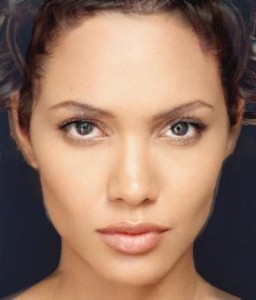Sep 29 2014
How Our Brains Respond to Ambiguous Images
 A new study looks at how our brains respond to images of celebrities made ambiguous by morphing two images into one, such as the combination of Halle Berry and Angelina Jolie shown here. The question is – will our brains fire in a way that represents the details of the picture, or will they fire based upon how we perceive the picture?
A new study looks at how our brains respond to images of celebrities made ambiguous by morphing two images into one, such as the combination of Halle Berry and Angelina Jolie shown here. The question is – will our brains fire in a way that represents the details of the picture, or will they fire based upon how we perceive the picture?
The researchers were able to study subjects who had small electrodes placed on the surface of their brains for clinical purposes. Such electrodes are capable of detecting the firing of a single brain neuron. They showed the subjects pictures of two celebrities to see how their brains responded. Typically a single neuron, which encodes the memory of that particular celebrity, would fire. They then showed them a morphed picture and asked them to identify the celebrity.
When subjects recognized Halle Berry, for example, the single neuron that previously fired when viewing Halle Berry also fired.
This is an interesting, but not unexpected, result. How does this fit into our understanding of brain function?
Our brains are perceptual machines. They sift sensory data and then try to find the best pattern fit to the data. This requires reconstruction and subconscious decisions about how to make the best fit. Once a match is found, then meaning is assigned to that perception. In the case of recognizing faces, once our brains make a match to a known person, the single neuron that represents that person (in the medial temporal lobe) fires, triggering all the memories associated with that person.
This makes sense in terms of our everyday experience. We can recognize someone who is familiar from any angle, in any lighting conditions, regardless of what they are wearing, whether they are wearing glasses or a hat, or whether they have changed their hairstyle or facial hair. This is why we would recognize Superman even with glasses. This is perhaps also why our significant others might become upset that we did not notice their new hairstyle.
Think of the times you have recognized a familiar actor even behind tremendous makeup. Something familiar about them triggered the single neuron in your brain that represents that actor.
This recent study is in line with that experience and with previous studies. We don’t necessarily consciously perceive the details that make up a familiar face. Our brains are not attending to the specific components of the face, at least not consciously, but rather to the overall pattern.
From other studies we also know that once an object or person is recognized, further memories are triggered. For things that our brains categorize as having agency (being able to think, have feelings, and act deliberately) further connections are made to the limbic system, where emotions are then triggered.
If this circuit is disrupted (the circuit connecting recognized images to the limbic system), then the emotional response does not occur. This results in what is known as Capgras syndrome. There are reported cases of people suffering from a stroke which results in this syndrome, who then feel that their spouse has been replaced by an imposter. They recognize their spouse, but the person just doesn’t “feel” like their spouse.
Another study, one of this year’s IgNobel prize recipients, studied pareidolia – recognizing a familiar pattern in random noise. They looked at the activation in the visual cortex when subjects were asked to look as pictures of noise they were told contained either a hidden number or hidden face. When subjects thought they saw a face in the noise, their brains activated in a pattern similar to when viewing an actual face – in what is called the fusiform face area.
This is why visual illusions can be so compelling – once a particular response is triggered in the brain, the resulting firing is the same, whether we are actively viewing an object, we just think we’re seeing the object (illusion), or we are remembering seeing the object.
Conclusion
The results of this recent study are not surprising, because they are consistent with our current understanding of how the brain processes information. Our brains are essentially pattern recognition machine, something they do exceedingly well (likely because they are massive parallel processors).
Our brains construct our perception of reality out of the sensory information it has. That construction is influenced by our expectations and memories, different sensory streams affecting each other, and inherent rules or assumptions that our brains follow. For example, objects tend to appear smaller when they are further away.
Our brains then make the best sense that it can out of the stimuli it has, and once that match is made the construction snaps into conscious focus – we think we see someone we know, we see a face in the noise, or we perceive a large object moving fast in the distance. Once the subconscious decision is made, the perception is solid and real to us, triggering a neuronal response the same as if we actually were experiencing the object we think we are, even if it is just an illusion.






